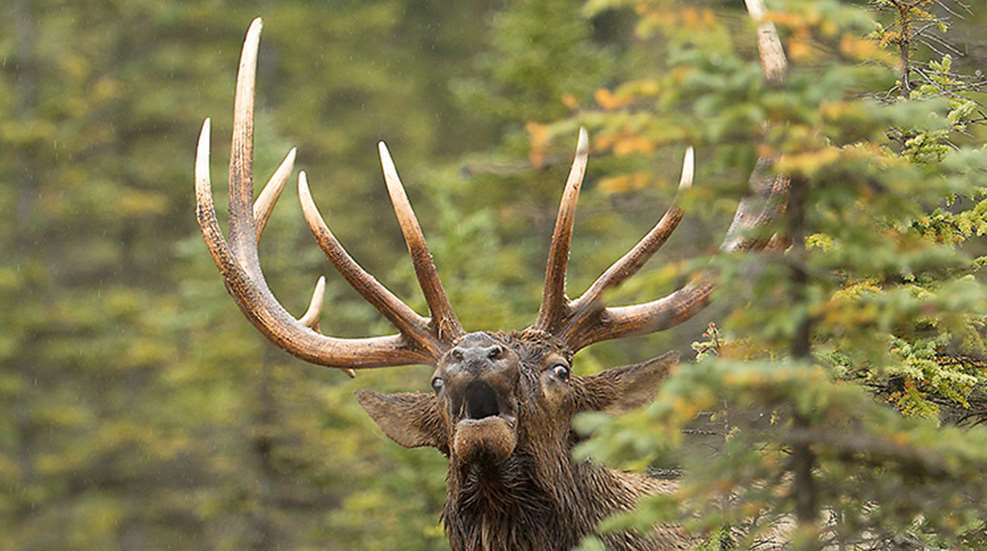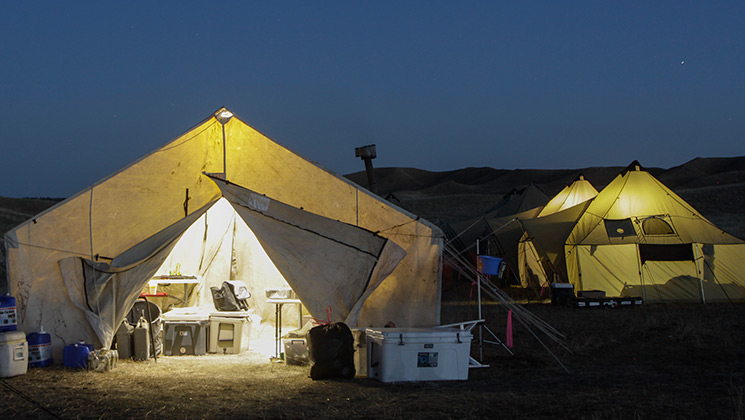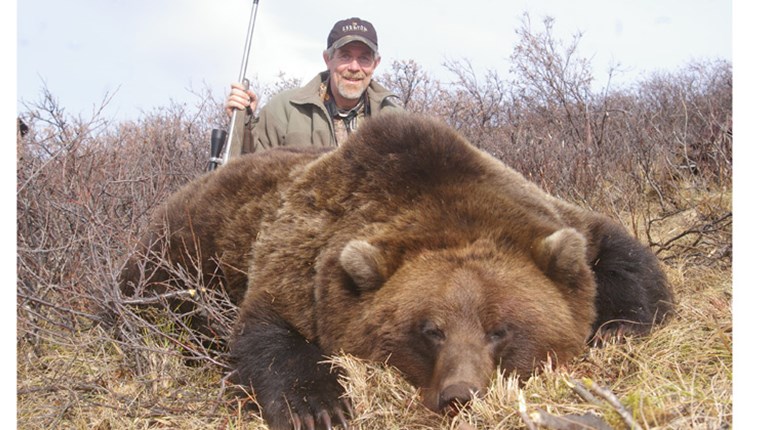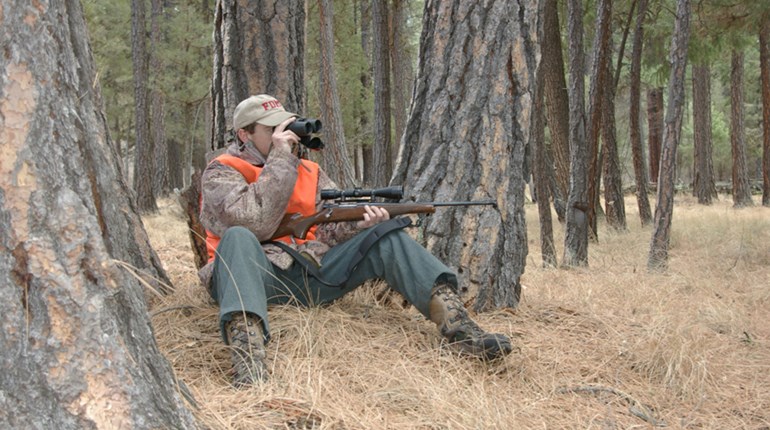
“There it is again,” I muttered half in disgust to my hunting partner Eddie as I tried to pinpoint the bugling bull on the far side of the canyon. I was more than elated at the discovery of the herd in the early evening hours, but my animosity arose from the fact we were on that same side of the canyon an hour earlier. At that time, though, the densely timbered slope was as silent as a spendthrift politician in a Washington oversight committee.
Peering through my Nikon, I eventually spotted tan outlines streaming through the tight timber. Several sported headgear. Regrettably, there were no clear openings for an ethical shot. We had to renegotiate the tricky, rock-strewn slope back to our starting point.
From scouting, I knew full well the intentions of the herd: They were headed to a neighboring mesa to graze under the cover of darkness, which was quickly approaching.
“We need to cross that canyon again if we’re going to have any shot at those bulls,” I told Eddie without sugar coating. “And we’re going to have to do it in record time to beat the end of shooting light.”
Daily news stories about America’s obesity epidemic might lead you to believe elk country should be getting less crowded and the elk should be as mellow as customers in a Colorado marijuana dispensary. That’s not the case. These days, crowded public hunting lands, the ever-increasing pressure of ATVs, and locked private gates all contribute to challenging conditions that require a very secretive approach.
I knew all that, which was what had led Eddie and me to our early-evening serenade.
Earlier in the day we’d left our ATVs parked along a trail miles away, but instead of hunting trailside meadows, we detoured into a rock-strewn chasm most hunters would define as unnavigable. On the way down, we slipped through the edge of thick, north-facing bedding cover and realized from the sign we saw that elk were nearby. We then scrambled up another sheer canyon to gain elevation and eventually catch the sound of that day’s-end bugle.
If you want to punch a tag in elk season you need to be determined. You also need to be sneaky. That sneakiness needs to extend from preseason scouting right up to the shot with bow or rifle.
Small Footprint, Big Results
Elk roam big territories that in most regions vary throughout the seasons. This means elk may be home one day and miles away the next. That’s the case in most mountain environments where elk migrate from high elevation to low elevation to escape winter’s wrath. As snowlines recede, elk return to high elevations for lush grazing, calving and refuge. Despite this mail-forwarding lifestyle, you shouldn’t barge in while scouting in the preseason or during a hunt. Bumping elk too often from their preferred refuge educates veteran cows that an area is unsafe. Can you say “adios amigos”?
Leave a minimal footprint. Begin by not camping right where elk live. The number of hunters that put in a camp where elk roamed only a few days earlier—or worse, right in the very country elk inhabit presently—astounds me. Backing off a mile or more from prime habitat allows elk patterns to continue, and actually makes your hunt easier.
Sure, big meadows, parks and mesas are great camping locations, but these are also the openings elk use to feed. They won’t feed there if the sounds of chainsaws and the scent of bacon become a constant on prevailing winds. Would you rather pack an elk out of a grassy meadow or from the bottom of a 1,000-foot-deep, rocky abyss?
Keep your distance. Like whitetails, elk pick up on the clues you’ve been in their territory. Unpressured elk calmly feed in openings before the season. You can inventory them from a safe distance with a binocular or a spotting scope. Jim Schell, a fourth-generation Wyoming native and 37-year outfitting veteran, operates Rough Country Outfitters and stresses a “keep-your-distance” approach.
“Do your scouting from afar with field glasses,” Schell underscores. “Use your eyes and ears, particularly in the mornings when elk are talking. That goes for preseason and during the hunt. Elk maintain traditional rutting grounds in many of our hunting areas, but even when I discover a new hub of activity, I stay clear of it until putting the kill on them.”
If the area you hunt is characterized by small openings with few observation opportunities, think “whitetail” and scout with a network of trail cameras. Set them to monitor waterholes, wallows, trails, saddles and natural mineral sites. Purchase the best batteries, and stock the cameras with the highest memory cards allowable. Check the cameras sparingly, but often enough to know if you need to adjust your hunting for lack of sightings. During visits, scour trails for onsite clues such as overlapping hoof marks and steaming piles of droppings.
Probably the best way to scout in a sneaky fashion is to not invade an area at all. Of course if you live in a different time zone than the elk, that may be your only option. If that’s the case, you need to use the digital world. You’ll have to surf the Internet, so grab your board. Review state elk density maps, success stats and how many licenses are issued in individual units. Phone calls to game wardens and area biologists should be on the to-do list. Ask about elk density and behavior during hunting season, but also inquire about hunting pressure and preferred hunting locations of past tag holders.
You may get all you need from that initial investigation, but continue down the information superhighway. Scour elk-hunting forums for information on the unit you plan to hunt. If you repeatedly read about a specific area, it might be wise to scratch it off the list because it likely will be visited by every other nimrod who sees the posts online.
Be a lemming: Join the crowd and utilize satellite images. Apps like ScoutLook Weather offer bonuses beyond Google Earth in map overlays, pinpoint weather, wind graphics and a logging system to store elk sign and elk sightings right on the map. Begin with the obvious and virtually scout likely elk habitat. After you note those locales (parks, stream-lined canyons), find the most inaccessible and roughest terrain nearby. If you’re serious about elk hunting, that’s where the elk and you will meet once hunting pressure peaks. You may get one crack at them in an easy location, but that expires more quickly than a day pass to Disney.
Zip It … or Not
If an elk responds with vigor, bugle until your lungs collapse. More than likely your lungs first will collapse from exhaustion as you traverse the unforgiving terrain of elk country defined by the sounds of silence. That doesn’t mean your elk calls should stay at camp. Like turkeys, elk ramp up the conversation at dawn and dusk. This chatter has the tendency to diminish soon after sunrise in hard-hunted public lands unless a blowup occurs from the excitement surrounding an estrous cow.
Use morning and afternoon windows as locating missions. You may pique a response with your calls, but don’t bet on an entire conversation. Bulls have no aversion to returning a bugle from a distance, but whether they sense hunting pressure or hope to avoid competition from other bulls, you’ll often discover clamped lips as you speed to intercept. Schell presses a zipped-mouth approach if the woods are alive with energized elk dialog, even if they sound off to your calls at a distance.
“If the elk are already talking you don’t need to add any more stimuli to the conversation. That’s when it’s time to be sneaky,” says Schell. “In most social groups of elk, the herd members know the voice of individual animals and bulls. If you throw a bugle at them close and they hear someone they don’t recognize, especially in a bedroom, it can freak them out. It’s game over. Just being quiet is sneaky. Be foot-quiet, voice-quiet and scent-quiet. That’s a successful strategy.”
If you’ve scouted, a quiet, sneaky approach won’t be a drawback. Chart a downwind, path-of-least-resistance course to vocal cues. Move fast since bugles at dawn and dusk likely indicate a mobile herd. They’ll often dwindle, but based on your scouting, advance to a likely endpoint. Morning elk push toward bedding cover such as north-facing slopes that offer shade and dense timber. Afternoon elk gravitate toward water and then feed. You may need to flip a coin, but watch for clues elk have been there before such as fresh rubs, droppings and beds.
To give your sneaky advance a head start, get out of bed an hour earlier than you’d planned. Slipping through the woods in the dark may seem like an accident waiting to happen, but elk communicate more in the relaxed setting of darkness; you’ll likely hear more elk talk. This “Dark-Knight” tactic allows you to slip close to herds before they bolt like Dracula at daybreak.
Last season, I happened into a herd that routinely visited a swath of rugged country void of road access. After my first, brief meeting with the local herd I quickly realized they shut up at sunrise and disappeared in an uncatchable trot. I moved my truck to the nearest trailhead and slept with the window open to catch midnight clues. More importantly, I was on the move anywhere from an hour or two before shooting light. That strategy landed me a front row seat to a bugle fest spurred by my single bugle under the cover of darkness. As the sun broke the horizon, bugling slowly ceased, but from scouting I had a good idea of where the herd was heading: a timber-covered flat. What I didn’t count on was their stop at a spring unbeknownst to me and then the approach of another hunter blowing his elk calls like a freshman band member learning the trumpet.
I was almost to a solid ambush location, so I watched the reaction of the herd to the increasing tempo of the hunter’s calls. The hunter had no idea of their whereabouts, but the lead cow knew of the hunter’s location. When she heard that poor trumpet solo, she threw up her head and pointed the group in the opposite direction. The bull bugled once to calm the chaos, but there was no stopping the determined matriarch. As I followed the trail of elk dust, I could still hear the hunter in the background blasting and yearning for herd acceptance. It never came.
An hour later, without hearing a peep, I was peeking into yet another shady bowl to scratch it off the list of hideouts of the quiet bunch. They were there, and minutes later I was able to put my Mathews No Cam HTR to good use. It had been three hours since I had used my elk call.

Play Keep-Away
I sneakily and easily slipped away from that hunter trumpeting his elk calls, but certain circumstances force you to be even more deceiving if you want to keep a spicy-hot location to yourself. First, diminish the clues to your travels.
I hate having to use a vehicle to get to elk country. It’s an unmistakable clue as to where we are hunting. Other hunters can zero in on your location as easily as if they spied you slipping into an elk herd. Oftentimes, a savvy challenger only needs to glance at a map to deduce where you and the elk may convene.
So I like to park in an obscure location that could be the jumping-off point into two or more canyons, slopes or basins. If possible, don’t park at a trailhead that denotes a one-way trail to your best location. That’s like leaving a breadcrumb trail right to the elk.
Instead, park away from a trail endpoint, leaving some doubt as to your intentions. Another tactic to use while parking is to point your vehicle in the opposite direction of your planned hunting zone. Think about it. When you drive to your house, to work, the market or wherever, don’t you stop with your vehicle’s front end pointed exactly where you intend to go?
Finally, I rarely hike on a dusty or muddy trail. This may seem like a paranoid move (I embrace that quality), but I don’t want to leave boot tracks. What do you and I do as savvy elk hunters? We constantly monitor the ground for elk sign. Seeing someone’s boot tracks could spur other hunters to follow the same trail out of curiosity. Curiosity killed the cat, and it could kill your hunt.
The single most effective strategy begins months in advance. You need to be physically fit and walk away from the soft crowd. Your ability to hike into remote areas increases your success and decreases the pain of removing an elk after success. Most of my elk hunting begins after a 2-mile hike from camp. It’s nothing to add another 5 or more miles in a day before I turn around and return to camp. And those aren’t Central Park miles either. They include routine ascents and descents of 1,000 feet or more.
“To be the sneakiest you need to get off the beaten path,” says Schell. “Go beyond the quarter-mile distance most wannabe hunters hike. And get off of the ATV. There’s no way to be sneaky, stopping along the trail on your ATV and bugling into the woods. That move only educates elk, making them even more call-shy. Put some miles between you and the road.”
Eddie and I faced several hundred feet of descent and then a brutal jog upwards, hurdling downed timber up the other side of the canyon in an attempt to catch the herd before dark. Drenched in sweat, we reached the edge of the mesa and crawled between junipers to see if we could get a glimpse of the target herd. Our jaws dropped at the sight!
From the other side of the canyon, I estimated maybe 30 elk were over here. But now, scattered across the opening were more than 200 head! With no time to waste we field-judged several prospects, and with a bit of help from above, the biggest bull was the closest at 264 yards. Eddie didn’t hesitate and sent a Hornady SST downrange. Our sneaky pursuit ended at the report of the rifle, but so did our hunt. Fortunately, darkness veiled the recovery of the trophy bull to keep our exact location a secret from other hunters searching for elk success.





































